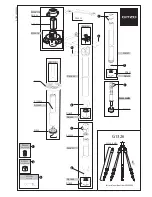
4-7
Chapter 4 Outdoor Equipment Maintenance
Redline Communications Inc. Confidential and Proprietary
The IF cable path should also be checked, to ensure it's not being shared with any other
cables (example AC power cables), as these can cause interference to the communication
between the radio and the IDU. If possible the IF cables should be separately routed and
shielded from any source of interference along its path between the ODU and IDU.
If you are replacing this cable, you should characterize the loss profile before using the
assembled cable in your system.
Annually you should re-characterize the loss profile of the cable and record the results in
your maintenance records. A network analyzer is required for this task.
RF Cable
Inspecting the Complete RF System
The quality of service (QoS) that you can provide is largely dependent on the performance
of the antenna and cables connecting your radio to the antenna and to the sector controller
indoor unit.
Before any useful maintenance can be performed it is essential to know how your system
is supposed to operate and also to know the licensed operating parameters. Your installers
need to verify the performance of the IF and RF cables and antenna before installation and
then again immediately after installing and commissioning a system. All performance
values should be recorded and used as a reference point when performing routine
maintenance.
To ensure continued high quality performance a regular maintenance policy should be
implemented. Factors such as corroded connectors, bends and joints, water ingress into
the coaxial feeder and a detuned antenna can all degrade the system performance.
In the case of a directional antenna many factors such as current, phase, self and mutual
impedance, monitoring system and transmission lines can interact to impact performance
and affect a service area.
Regular maintenance must include the inspection of all connections and connectors in all
circuits, tower-mounted antenna monitor loops, or current transformers at the output of the
tee-matching network in the ATU. Lighting circuits and photo-electric controls must be
checked and tested as well as pattern change contacts and control circuits.
Inspecting Outdoor Equipment
Perform the following inspection for your outdoor equipment installation.
Step 1
Ensure the ODU and antenna serial number's match your site's bill of materials or packing
list. Record all of the serial numbers.
Step 2
Ensure the tower or mast is stable and secured correctly.
Step 3
Ensure the antenna elevation and physical tilt match the values in your Network Design
and Cell Planning documents. Record these values.
















































